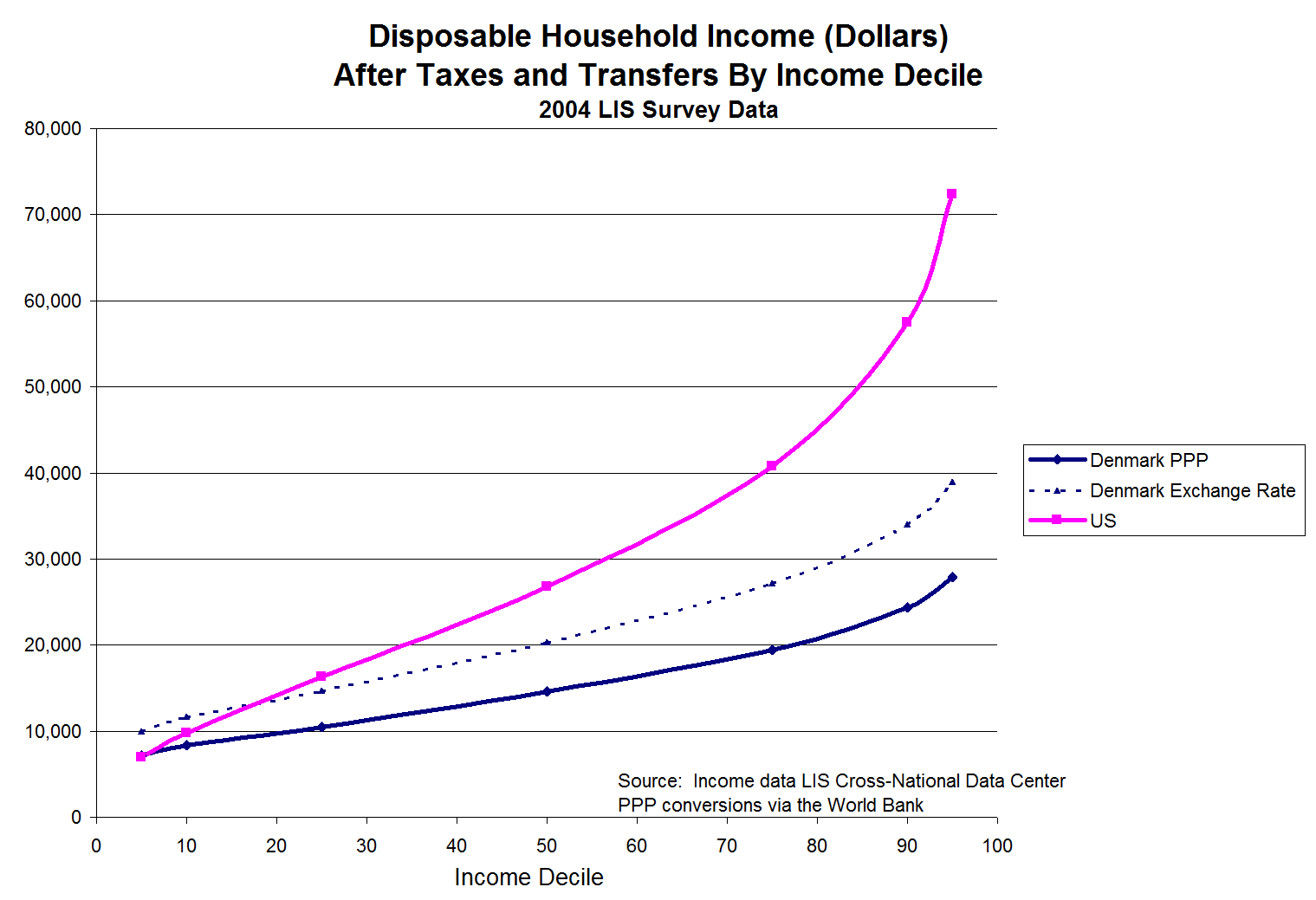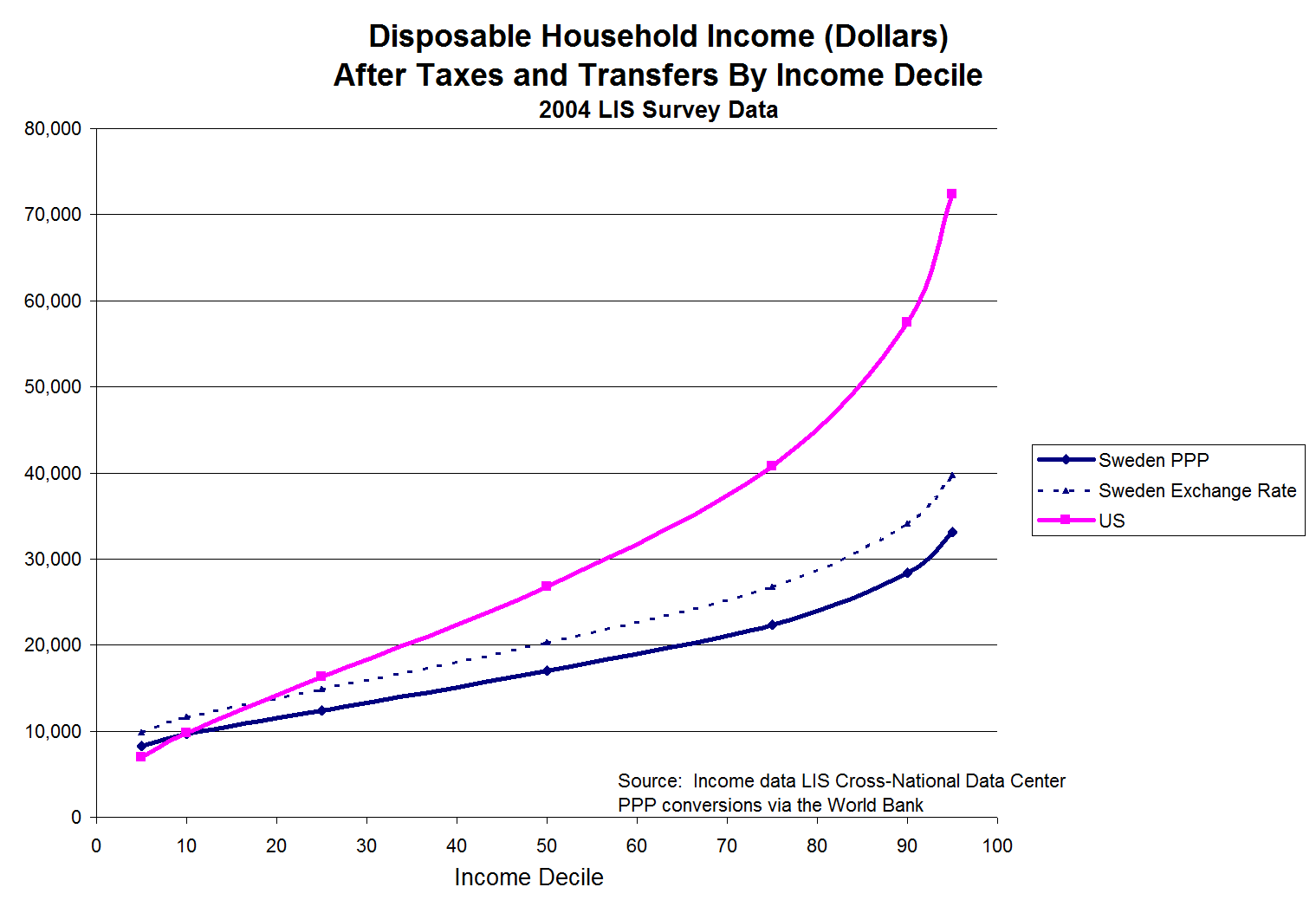I’ve already commented several times on the good and bad features of the Nordic Model, largely to correct the false narrative being advanced by Bernie Sanders (though I was writing on this issue well before the Vermont Senator decided to run for Chief Commissar President of the United States).
In any event, Sanders is a self-proclaimed socialist and he says he wants to adopt Scandinavian policies in the United States because he thinks this will boost the poor.
Yet he may want to check his premise. Warren Meyer of Coyote Blog looked at the numbers and concluded that poor people are not better off in Nordic countries.
When folks like Bernie Sanders say that we have more income inequality than Sweden or Denmark, this is certainly true. …Sanders implies that this greater income equality means the poor are better off in these countries, he is very probably wrong. Because the data tends to show that while the middle class in the US is richer than the middle class in Denmark, and the rich in the US are richer than the rich in Denmark, the poor in the US are not poorer than those in Denmark. And isn’t this what we really care about? The absolute well-being of the poor?
Regarding his rhetorical question, the answer may not be yes. As Margaret Thatcher famously observed, some statists resent the rich more than they care about the less fortunate.
But the motives of the left is not our focus today. Instead, we want to know whether the poor are worse off in the U.S. than in Nordic nations.
Meyer’s article seeks to measure living standards for different income classes in the United States and then compare them to living standards for different income classes in Denmark and Sweden.
Meyer found some data on this issue from the Economic Policy Institute, the same source that I cited in my 2007 study on the Nordic Model (see Figure 9 on page 11).
But he wanted to update and expand on that data. So he started digging.
I used data from the LIS Cross-National Data Center. …the same data set used by several folks on the Left (John Cassidy and Kevin Drum) to highlight inequality issues… I then compared the US to several other countries, looking at the absolute well-being of folks at different income percentile levels. I have used both exchange rates and purchasing price parity (PPP) for the comparison.
And what did Meyer discover?
…all the way down to at least the 10th percentile poorest people, the poor in the US are as well or better off than the poor in Denmark and Sweden. And everyone else, including those at the 20th and 25th percentile we would still likely call “poor”, are way better off in the US.
Here’s the data for Denmark.
As you can see, the poor in both nations have similar levels of income, but all other income classes in the United States are better off than their Danish counterparts
And here’s the comparison of the United States and Sweden.
Once again, it’s very clear that America’s smaller overall burden of government generates more prosperity.

So here’s the bottom line. If you’re a poor person in America, your income is as high as the incomes of your counterparts in Scandinavia.
But you have a much better chance of out-earning your foreign counterparts if you begin to climb the economic ladder. Yes, that means more “inequality,” but that’s why the term is meaningless. By the standards of any normal and rational person, the US system is producing better outcomes.
Now that we’ve ascertained that the United States is more prosperous than Nordic nations, let’s now say something nice about those countries by defending them against the scurrilous accusation that they follow socialist policies.
I’ve already shared my two cents on this issue, pointing out that neither Bernie Sanders nor Scandinavian nations properly can be considered socialist.
But if you don’t believe me, maybe you’ll believe the Prime Minister of Denmark, as reported by Vox.
Bernie Sanders…consistently references the social models of the Nordic states — and especially Denmark — as his idea of what democratic socialism is all about. But…Danish Prime Minister Lars Løkke Rasmussen said…he doesn’t think the socialist shoe fits. “I know that some people in the US associate the Nordic model with some sort of socialism,” he said, “therefore I would like to make one thing clear. Denmark is far from a socialist planned economy. Denmark is a market economy.”
The key statement from the Prime Minister is that Denmark is not a “planned economy,” because that is what you automatically get when the government is in charge of allocating resources and controlling the means of production.
But since that doesn’t happen in Denmark, Mr. Rasmussen is exactly right that his country isn’t socialist.
It’s high tax, and that’s not good. There’s a huge amount of dependency on government because of redistribution programs, and that’s also not good.
But a high-tax welfare state is not the same as socialism. Indeed, nations such as Denmark and Sweden would be somewhere in between France and the United States on my statism spectrum.
By the way, don’t let anyone get away with claiming that Scandinavian nations somehow prove that big government isn’t an obstacle to a country becoming rich.
Yes, Nordic countries are rich by world standards, but the key thing to understand is that they became prosperous in the late 1800s and early 1900s, back when government was very small.
It wasn’t until the 1960s that nations such as Denmark and Sweden adopted big welfare states. And, not coincidentally, that’s when economic growth slowed in those countries.

